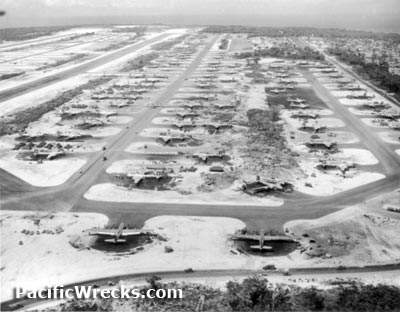
USAAF 1945

USAAF August 1945 |
Location
North Field is located near Pati Point on the northeast of Guam Island in the Southern Mariana Islands (Territory of Guam) in the Mariana Island Group (Mariana Islands) in the United States of America (USA). Still in use today as Andersen Air Force Base (Andersen AFB) as a military airport.
Construction
During November 1944, U.S. Navy (USN) Construction Battalion "Seabees" began building this airfield as a base for B-29 Superfortress bombers that was established by February 3, 1945.
Wartime History
During late 1944 the first American aircraft began arriving with 20th Air Force (20th AF) B-29 Superfortress bombers arriving in January 1945 for strategic bombing campaign against Japan.
American units based at North Field
U.S. Navy (USN)
USN VD-4 from Enewetok Oct 12 - Nov 23, 1944 to USA
U.S. Army Air Force (USAAF)
314th Bomb Wing (B-29) March 1945
35th FG, 41st FS (F-86s) Yokota arrives August 5, 1956-1958
316th BW USA arrives January 16, 1945
19th BG, Headquarters (HQ)
arrives January 16, 1945
19th BG, 28th BS (B-29) USA arrives January 16, 1945
19th BG, 30th BS (B-29) USA arrives January 16, 1945
19th BG, 93rd BS (B-29) USA
arrives January 16, 1945
29th BG, 6th BS USA arrives January 17, 1945
29th BG, 43rd BS USA arrives January 17, 1945
29th BG, 52nd BS USA arrives January 17, 1945
39th BG, HQ USA February 18, 1945
330th BG, HQ USA February 18, 1945
330th BG, 457th BS (B-29) USA February 18, 1945
330th BG, 458th BS (B-29) USA February 18, 1945
330th BG, 459th BS
(B-29) USA February 18, 1945
Naming
On October 7, 1949 North Field was renamed Andersen Air Force Base (Andersen AFB) in honor of Brigadier General James R. Andersen, O-16407 deputy commander of the 20th Air Force (20th AF) who went missing February 26, 1945 as a passenger aboard C-87A Liberator Express 41-24174 over the Pacific Ocean between Kwajalein and Hawaii. At Andersen's memorial marker is a Andersen Air Force Base dedication plaque: "Andersen Air Force Base - Guam Marianas Islands Dedicated 15 April 1950 in memory of Brig General James Roy Andersen 1904-1945 Missing in action 26 February 1945 while serving as Chief of Staff Pacific Ocean Area".
Postwar
During 1951, Andersen was selected as a Strategic Air Command (SAC) 90 day rotation base for bombers outside the United States for B-29 then later B-47, B-50 and KB-29. On April 1, 1955 transfered to the 3960th Air Base Wing (3960th ABW).
Vietnam War
During the Vietnam War, Andersen AFB based B-52s for bombing missions against Vietnam including 1965-1973 "Operation Arc Light" for B-52s to provide close air support for ground forces in Vietnam. Also, Andersen was used for Operation Bullet Shot to base U.S. technicians supporting the military. Between December 18-29, 1972 during "Operation Linebacker II" Andersen AFB was used by B-52s bombing missions against Vietnam. During the eleven day operation, roughly 50% of the SAC bomber force and 75% of all combat crews based at Andersen AFB. In 1975 during Operation New Life, Andersen AFB was used to fly relief aid and house Vietnamese evacuees including roughly 40,000 refugees after the fall of Saigon and the base processed 109,000 to the United States.
Cold War
During the later 1970s, Andersen AFB returned to normal operations but remained a SAC base with bombers flying via this location on via Alaska, Korea and Australia and during surveillance operations for the U.S. Navy (USN).
During the 1960s based the 54th Weather Reconnaissance Squadron "Typhoon Chasers" to track typhoons in the Pacific Ocean and provide warnings to military and civilian authorities until the unit was deactivated September 1987. During the NASA Space Shuttle era, Andersen was designated as a safe landing point for the Space Shuttle in the even of an emergency landing but was never used.
In 1983, Andersen AFB was one of the few bases with Harpoon anti-ship misses for B-52 bombers. In 1989 control was transfered to the Pacific Air Forces (PACAF) and the 633rd Air Base Wing (633rd ABW) was activated at Andersen.
In August 1990, Andersen shipped munitions to U.S. and coalition forces in the Persian Gulf for Operation Desert Shield and Desert Storm. In June 1991, after the eruption of Mount Pinatubo during Operation Fiery Vigil, Andersen was used to house U.S. evacuees and due to the volcanic ash, the 13th Air Force (13th AF) evacuated Clark AFB to operate from this location.
In 1994, the 36th Air Base Wing (36th ABW) was activated at Andersen and the USN Helicopter Combat Support Squadron Five (HC-5) arrived from NAS Agana to operate from this location and was later redesignated HSC-25.
In 2006, the host unit was redesignated the 36th Wing (PACAF). During 2007, the south runway removed and replaced in a $50.6 million upgrade of the runway, taxiways and extensions was awarded to the Tutor-Perini Corporation and local subsidiary Black Construction Company.
Today
Still in as Andersen Air Force Base (Andersen
AFB) as a military airport. Today, bases the U.S. Air Force (USAF) 36th Wing (PACAF) plus 624th Regional Support Group, 734th Air Mobility Support Squadron (Air Mobility Command), Detachment 1, 69th Reconnaissance Group operating the Northrop Grumman RQ-4 Global Hawk and U.S. Navy (USN) Helicopter Sea Combat Squadron Two-Five (HSC-25) operating the Sikorsky MH-60S.
Andersen Air Force Base has two parallel runways. The first is oriented 24L/06R measures 11,185' x 200' surfaced with PEM (Partially concrete, asphalt or bitumen-bound macadam). The second is oriented 24R/06L measures 10,558' x 200' surfaced with PEM. Airport codes: FAA: UAM ICAO: PGUA IATA: UAM.
References
U.S. Air Force (USAF) James Roy Andersen (photo)
"North Field AFB, Guam was renamed Andersen AFB in his honor on October 7, 1949"
U.S. Air Force (USAF) Andersen Air Force Base official website
Contribute
Information
Do you have photos or additional information to add?
Last Updated
May 3, 2025
|

Map Fallingrain |

